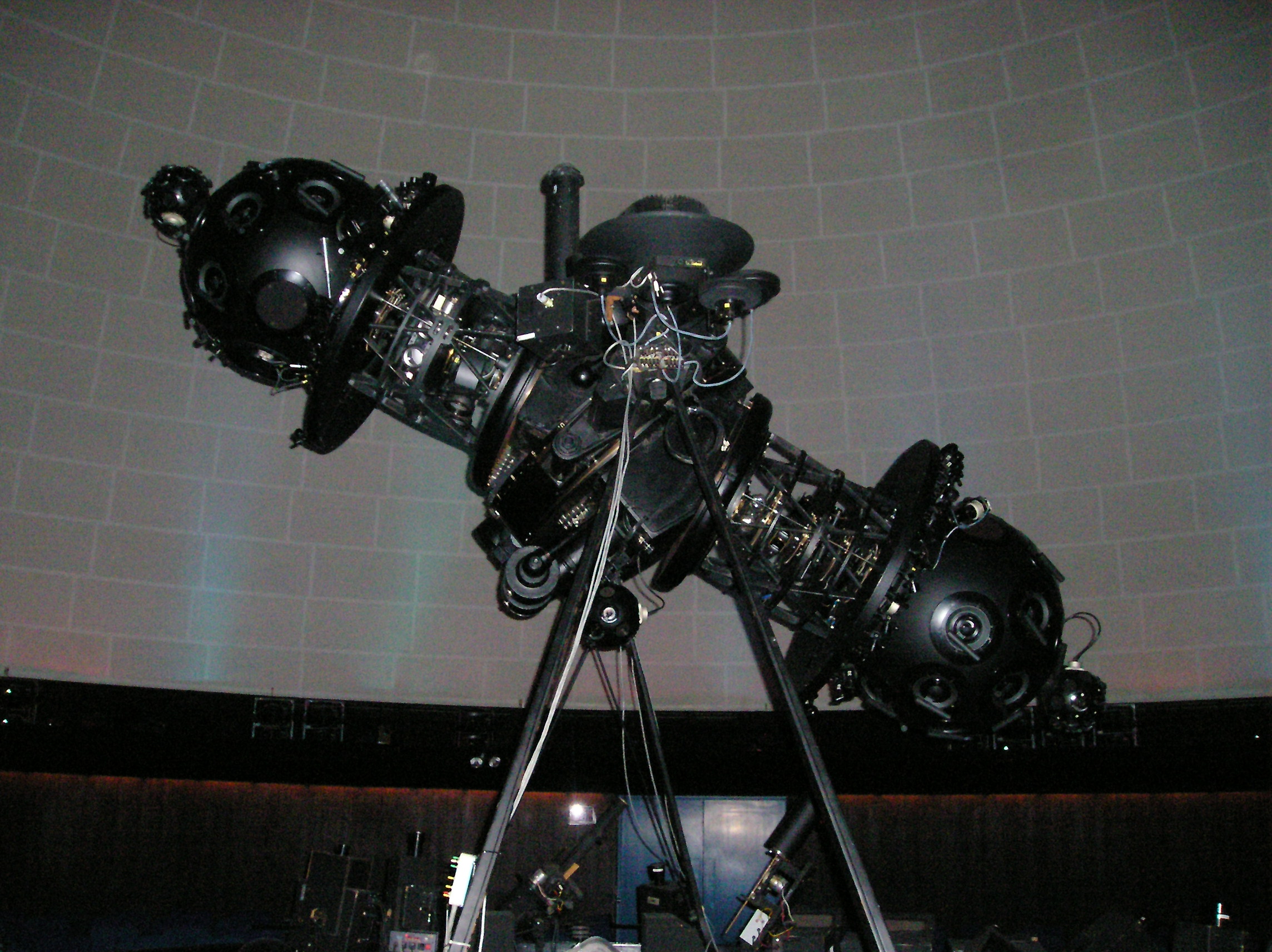|
Planetarium Projector
A planetarium projector, also known as a star projector, is a device used to project images of celestial objects onto the dome in a planetarium. Modern planetarium projectors were first designed and built by the Carl Zeiss AG, Carl Zeiss Jena company in Germany between 1923 and 1925, and have since grown more complex. Smaller projectors include a set of fixed stars, Sun, Moon, and planets, and various nebulae. Larger machines also include comets and a far greater selection of stars. Additional projectors can be added to show twilight around the outside of the screen (complete with city or country scenes) as well as the Milky Way. Still others add coordinate lines and constellations, photographic slides, laser displays, and other images. The IMAX, OMNIMAX Film, movie system (now known as IMAX Dome) was originally designed to operate on planetarium screens. Companies that make (or have made) planetarium projectors include Carl Zeiss AG, Carl Zeiss Jena (Germany), Armand Spitz, Spi ... [...More Info...] [...Related Items...] OR: [Wikipedia] [Google] [Baidu] |
Horizon
The horizon is the apparent curve that separates the surface of a celestial body from its sky when viewed from the perspective of an observer on or near the surface of the relevant body. This curve divides all viewing directions based on whether it intersects the relevant body's surface or not. The ''true horizon'' is a theoretical line, which can only be observed to any degree of accuracy when it lies along a relatively smooth surface such as that of Earth's oceans. At many locations, this line is obscured by terrain, and on Earth it can also be obscured by life forms such as trees and/or human constructs such as buildings. The resulting intersection of such obstructions with the sky is called the ''visible horizon''. On Earth, when looking at a sea from a shore, the part of the sea closest to the horizon is called the offing. Pronounced, "Hor-I-zon". The true horizon surrounds the observer and it is typically assumed to be a circle, drawn on the surface of a perfectly sph ... [...More Info...] [...Related Items...] OR: [Wikipedia] [Google] [Baidu] |
Cardinal Directions
The four cardinal directions or cardinal points are the four main compass directions: north (N), south (S), east (E), and west (W). The corresponding azimuths ( clockwise horizontal angle from north) are 0°, 90°, 180°, and 270°. The four ordinal directions or intercardinal directions are northeast (NE), southeast (SE), southwest (SW), and northwest (NW). The corresponding azimuths are 45°, 135°, 225°, and 315°. The intermediate direction of every pair of neighboring cardinal and intercardinal directions is called a secondary intercardinal direction. These eight shortest points in the compass rose shown to the right are: # West-northwest (WNW) # North-northwest (NNW) # North-northeast (NNE) # East-northeast (ENE) # East-southeast (ESE) # South-southeast (SSE) # South-southwest (SSW) # West-southwest (WSW) Points between the cardinal directions form the points of the compass. Arbitrary horizontal directions may be indicated by their azimuth angle value. Determinatio ... [...More Info...] [...Related Items...] OR: [Wikipedia] [Google] [Baidu] |
Omicron Ceti
Mira (), designation Omicron Ceti (ο Ceti, abbreviated Omicron Cet, ο Cet), is a red-giant star estimated to be 200–300 light-years from the Sun in the constellation Cetus. ο Ceti is a binary stellar system, consisting of a variable red giant (Mira A) along with a white dwarf companion ( Mira B). Mira A is a pulsating variable star and was the first non-supernova variable star discovered, with the possible exception of Algol. It is the prototype of the Mira variables. Nomenclature ο Ceti ( Latinised to ''Omicron Ceti'') is the star's Bayer designation. It was named Mira (Latin for 'wonderful' or 'astonishing') by Johannes Hevelius in his ''Historiola Mirae Stellae'' (1662). In 2016, the International Astronomical Union organized a Working Group on Star Names (WGSN) to catalog and standardize proper names for stars. The WGSN's first bulletin of July 2016 included a table of the first two batches of names approved by the WGSN, which included Mira for this star. ... [...More Info...] [...Related Items...] OR: [Wikipedia] [Google] [Baidu] |
Algol
ALGOL (; short for "Algorithmic Language") is a family of imperative computer programming languages originally developed in 1958. ALGOL heavily influenced many other languages and was the standard method for algorithm description used by the Association for Computing Machinery (ACM) in textbooks and academic sources for more than thirty years. In the sense that the syntax of most modern languages is "Algol-like", it was arguably more influential than three other high-level programming languages among which it was roughly contemporary: FORTRAN, Lisp, and COBOL. It was designed to avoid some of the perceived problems with FORTRAN and eventually gave rise to many other programming languages, including PL/I, Simula, BCPL, B, Pascal, Ada, and C. ALGOL introduced code blocks and the begin...end pairs for delimiting them. It was also the first language implementing nested function definitions with lexical scope. Moreover, it was the first programming language which gave ... [...More Info...] [...Related Items...] OR: [Wikipedia] [Google] [Baidu] |
Variable Stars
A variable star is a star whose brightness as seen from Earth (its apparent magnitude) changes systematically with time. This variation may be caused by a change in emitted light or by something partly blocking the light, so variable stars are classified as either: * ''Intrinsic variables'', whose luminosity actually changes periodically; for example, because the star swells and shrinks. * ''Extrinsic variables'', whose apparent changes in brightness are due to changes in the amount of their light that can reach Earth; for example, because the star Eclipsing binaries, has an orbiting companion that sometimes eclipses it. Many, possibly most, stars exhibit at least some oscillation in luminosity: the energy output of the Sun, for example, varies by about 0.1% over an 11-year solar cycle. Discovery An ancient Egyptian calendar of lucky and unlucky days composed some 3,200 years ago may be the oldest preserved historical document of the discovery of a variable star, the eclipsin ... [...More Info...] [...Related Items...] OR: [Wikipedia] [Google] [Baidu] |
Spica
Spica is the brightest object in the constellation of Virgo and one of the 20 brightest stars in the night sky. It has the Bayer designation α Virginis, which is Latinised to Alpha Virginis and abbreviated Alpha Vir or α Vir. Analysis of its parallax shows that it is located 250 light-years from the Sun. It is a spectroscopic binary star and rotating ellipsoidal variable; a system whose two stars are so close together they are egg-shaped rather than spherical, and can only be separated by their spectra. The primary is a blue giant and a variable star of the Beta Cephei type. Spica, along with Arcturus and Denebola—or Regulus, depending on the source—forms the Spring Triangle asterism, and, by extension, is also part of the Great Diamond together with the star Cor Caroli. Nomenclature In 2016, the International Astronomical Union organized a Working Group on Star Names (WGSN) to catalog and standardize proper names for stars. The WGSN's first bulletin o ... [...More Info...] [...Related Items...] OR: [Wikipedia] [Google] [Baidu] |
Rigel
Rigel is a blue supergiant star in the constellation of Orion. It has the Bayer designation β Orionis, which is Latinized to Beta Orionis and abbreviated Beta Ori or β Ori. Rigel is the brightest and most massive componentand the eponymof a star system of at least four stars that appear as a single blue-white point of light to the naked eye. This system is located at a distance of approximately . A star of spectral type B8Ia, Rigel is calculated to be anywhere from 61,500 to 363,000 times as luminous as the Sun, and 18 to 24 times as massive, depending on the method and assumptions used. Its radius is more than seventy times that of the Sun, and its surface temperature is . Due to its stellar wind, Rigel's mass-loss is estimated to be ten million times that of the Sun. With an estimated age of seven to nine million years, Rigel has exhausted its core hydrogen fuel, expanded, and cooled to become a supergiant. It is expected to end its life as a typeII su ... [...More Info...] [...Related Items...] OR: [Wikipedia] [Google] [Baidu] |
Antares
Antares is the brightest star in the constellation of Scorpius. It has the Bayer designation α Scorpii, which is Latinisation of names, Latinised to Alpha Scorpii. Often referred to as "the heart of the scorpion", Antares is flanked by Sigma Scorpii, σ Scorpii and Tau Scorpii, τ Scorpii near the center of the constellation. Distinctly reddish when viewed with the naked eye, Antares is a slow irregular variable star that ranges in brightness from an apparent visual magnitude of +0.6 down to +1.6. It is on average list of brightest stars, the fifteenth-brightest star in the night sky. Antares is the brightest and most evolved stellar member of the Scorpius–Centaurus association, the nearest Stellar association#OB associations, OB association to the Sun. It is located about from Earth at the rim of the Upper Scorpius subgroup, and is illuminating the Rho Ophiuchi cloud complex in its foreground. Classified as stellar classification#Spectral types, spectral type Stellar ... [...More Info...] [...Related Items...] OR: [Wikipedia] [Google] [Baidu] |
Betelgeuse
Betelgeuse is a red supergiant star in the constellation of Orion (constellation), Orion. It is usually the List of brightest stars, tenth-brightest star in the night sky and, after Rigel, the second brightest in its constellation. It is a distinctly reddish, semiregular variable star whose apparent magnitude, varying between +0.0 and +1.6, with a main period near 400 days, has the widest range displayed by any first-magnitude star. Betelgeuse is the brightest star in the night sky at near-infrared wavelengths. Its Bayer designation is , Latinisation of names, Latinised to Alpha Orionis and abbreviated Alpha Ori or . With a radius between 640 and 764 times that of the Sun, if it were at the center of the Solar System, its surface would lie beyond the asteroid belt and it would engulf the orbits of Mercury (planet), Mercury, Venus, Earth, and Mars. Calculations of Betelgeuse's mass range from slightly under ten to a little over twenty times that of the Sun. For ... [...More Info...] [...Related Items...] OR: [Wikipedia] [Google] [Baidu] |
Zeiss Projector
A Zeiss projector is one of a line of planetarium projectors manufactured by the Carl Zeiss AG, Carl Zeiss Company. Main models include Copernican (1924), Model I (1925), Model II (1926), Model III (1957), Model IV (1957), Model V (1965), Model VI (1968), Spacemaster (1970), Cosmorana (1984), Skymaster ZKP2 (1977), and Skymaster ZKP3 (1993). The first modern planetarium projectors were designed and built in 1924 by the Zeiss Works of Jena, Germany.Christopher Dewdney. Acquainted with the Night: Excursions Through the World After Dark'. Bloomsbury Publishing USA; 2005 [cited 14 October 2011]. . p. 278–279. Zeiss projectors are designed to sit in the middle of a dark, dome-covered room and project an accurate image of the stars and other astronomical objects on the dome. They are generally large, complicated, and imposing machines. The first Zeiss Mark I projector (the first planetarium projector in the world) was installed in the Deutsches Museum in Munich in August, 1923 ... [...More Info...] [...Related Items...] OR: [Wikipedia] [Google] [Baidu] |







